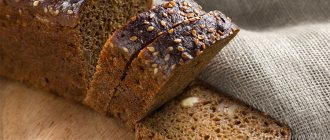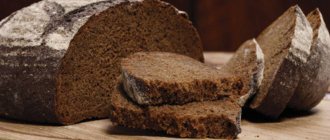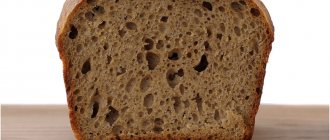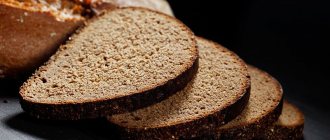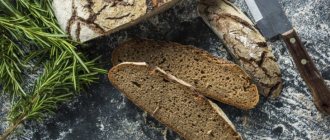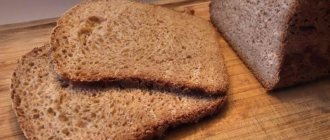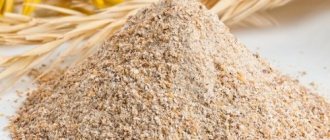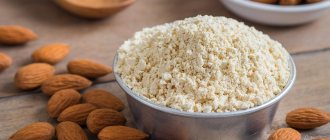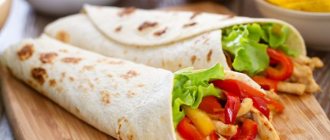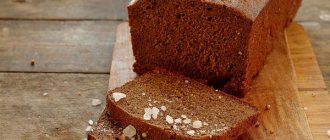Tatyana Maryina Country and world September 16, 2019
Only on the website
Since bread appeared on the Russian table, songs, fairy tales, proverbs and sayings have been written about it. Starting from the classic “Bread is the head of everything” to the life-affirming “If you eat rye, you will sleep with your wife more often.” But here’s the problem: some incomprehensible force is turning Russian consumers away from rye bread.
Photo: Pixabay/Nordwing
They scratched the bottom of the barrel. Empty?
Rye has been going out of fashion for a long time. Today, the share of its consumption is 10 - 12% of the total volume of bakery products. The young and middle generations make their choice in favor of “lush” white bread and loaves. Only the older generation remains a true supporter of rye, and even then not all of its representatives. Our grandparents (especially grandmothers) also increasingly prefer a soft bun. Although many explain this by the fact that in St. Petersburg that “rye round” - with a unique aroma and crispy crust, which was the pride of bakery in the “Leningrad” times - is hard to find these days.
At the same time, Russia has historically always been considered a “rye” power. Black bread from rye flour began to be baked in Rus' in the 11th century. And everyone ate it, not excluding rich and influential people. Wheat flour was used for church prosphora and holiday rolls. “It’s bad, brother, to live in Paris: there’s nothing to eat; you can’t ask for black bread,”
- Count Sheremetev complained to the poet Pushkin almost two hundred years ago, returning from a trip to Europe.
Winter rye was the main grain crop in Russia. Its crops remained stably at the level of 25 - 27 million hectares and amounted to 50 - 55% of the world's total. Only in the late 1960s did rye give way to wheat.
And here is the recent statement of the Russian Grain Union: in the 2019/20 season, rye can break all anti-records.
For this year's harvest, 872 thousand hectares were allocated to it - 108 thousand less than last year. “In recent years and even decades, the area under rye has been falling,
- commented at the Institute of Agricultural Market Studies (IKAR).
“ If before 1990, 8.2 million hectares were sown with it, then by now the area sown has decreased almost tenfold
.
It is known that all developments in our agricultural sector are monitored by the US Department of Agriculture. For this purpose, the department has created a special unit - the Foreign Agricultural Service. When making forecasts for the development of sectors of the Russian agro-industrial complex, foreign analysts are rarely mistaken. And then they missed. In the spring it was predicted that our grain sowers would occupy at least one million hectares with rye. But the forecasts did not come true - it was more profitable for us to occupy the hectares with wheat.
Russia entered the current food season with historically minimal reserves and high prices for rye, according to ICAR. This is due to the low harvest last year and high export supplies. That is, having received a meager harvest, a considerable part of it - 280 thousand tons (versus 70 thousand tons in 2021) was taken out of the country. Everything that was left turned out to be in short supply and, accordingly, increased in price.
Today, the stability of the food rye market will largely depend on Belarus. If last year it bought rye from us, now Belarusian rye flour is beginning to fill the Russian market.
Greetings from Borodino Field
No matter what they say about the fall in consumer demand for rye goods, this demand remains. Both for the flour itself (for home baking), and for rye porridge with bran and germ, flattened porridge, rye-wheat grains; rye flakes that do not require cooking, toasted grains of young rye (for dietary nutrition). Bread, the recipe of which includes rye flour, has not been forgotten either.
Today, bread technologists include black bread as rye and rye-wheat (with a predominant share of rye flour of more than 50%), as well as custard rye-wheat products. Of the latter, the most famous is Borodinsky bread.
Related article:
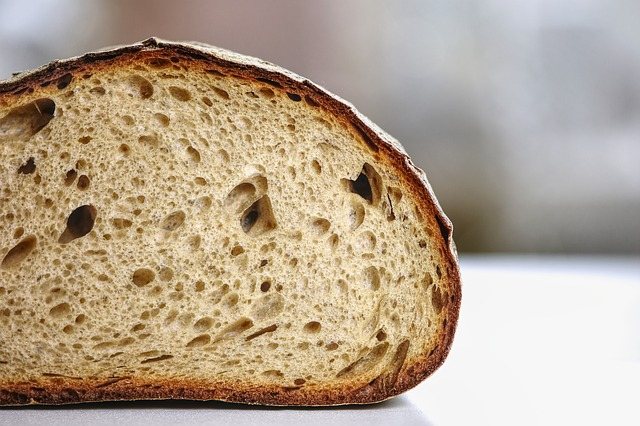
Loaf with grain addition. Which bread is the healthiest?
...After the battle on the Borodino field, the widow of the deceased General Tuchkov founded the Spaso-Borodinsky Convent. The monastery had its own bakery, where a recipe for bread made from rye flour was developed. This bread did not go stale for a long time, had a rich taste, a glossy surface and was sprinkled with caraway seeds (coriander entered the recipe much later). True, it was originally called “Funeral”, and only at the end of the 19th century it was called “Borodinsky”.
Either a legend, or a true story... However, there is another version. As if the bread was named after the famous Russian composer Alexander Porfiryevich Borodin. His main education was as a physician, and the idea to create such bread came to him after a trip with a group of colleagues to Italy. However, most historians reject this version, citing the fact that in southern countries rye was not cultivated as actively as in Russia.
In itself, bread made from pure rye flour is a product with a pronounced sourness. This “brightness” was dimmed by adding wheat flour to the rye flour. The best options include the classic “Darnitsky”, which, according to GOST, should contain 60% peeled rye flour and 40% first-grade wheat flour.
This bread is the brainchild of Leningrad bakers in 1933. However, the all-Union GOST established its recipe only in 1986 (GOST 26983-86 “Darnitsky Bread”). Currently, GOST 26983-15 is in force for bread, which came into force in January 2021 with a minor adjustment for 2021.
But for other rye, rye-wheat, wheat-rye breads, new GOST standards have not been published in modern Russia. Most of them are made according to the Soviet era standard - GOST 2077-84. Only from time to time is its relevance officially confirmed.
To the table, to the feeder, to the gas tank
In folk rye-bread art, a special place is given to the “sweet couple” - the son-in-law and his beloved mother-in-law. Here, too, they came up with sayings like this: “A crust of rye bread for yourself, a wheat loaf for your beloved mother-in-law.”
However, the modern “mother-in-law” is a young, athletic and fit person, an active fighter for a healthy lifestyle in general and for healthy eating in particular. A calculator clicks in her head: 100 grams of wheat treat has 325 kilocalories, rye crust has 298. Plus in favor of rye. There is more protein in wheat than in rye. Plus in favor of wheat. The difference in fats is small: 1.1 grams versus 1.7. But for carbohydrates: in every 100 grams of wheat bread there are 70 grams, in rye bread - 59. It is clear why the beloved mother-in-law chooses the latter - she protects her figure.
Scientific treatises have been written about the benefits of bread made from rye flour, where there are statements that rye can remove waste, salts, and toxins from the body and thus eliminate the causes of many diseases. That rye bread improves heart function, since rye flour contains a sufficient amount of unsaturated fatty acids... Perhaps there is only one caveat: bread consisting of 100% rye is still too heavy for daily consumption. And for those who suffer from stomach ailments, especially high acidity, it is completely contraindicated.
The year before last, participants in the Southern Grain Forum proposed that the Ministry of Agriculture develop a target program (“road map”) “Rye of Russia”. In their opinion, it would allow - quote: “to widely inform the population about the importance of rye bread in accordance with the concept of healthy nutrition” and ultimately “to increase the volume of consumption of rye products.”
The Ministry of Agriculture accepted the proposal, but when its head was changed, it was conveniently forgotten...
But with the light hand of Germany, the international project “Rye Belt” has been implemented for ten years now, designed to increase interest in breeding, technologies for cultivating and using rye. The project was supported by the countries of the European Union and, at one time, Russia and Belarus.
Mostly winter rye is grown throughout the world. Spring (kernel) is grown in small areas in some regions of Eastern Siberia. Currently, the State Register of Breeding Achievements includes 63 varieties of winter rye, of which 59 were created in Russia, 2 Belarusian and 2 more from Germany.
The Germans are interested in rye not only for food and feed purposes, but also for biofuel. About 400 tons of rye per year are processed there into bioethanol.
But in Denmark, more and more rye is used to feed livestock. Especially in specialized pig farms of farmers. At the same time, the area allocated for this crop occupies only 50 thousand hectares. In Poland, the harvest is divided into approximately two equal parts: one for food, the other for livestock.
According to Petrostat, consumer prices for food products in August decreased by 1.3% compared to July. Since the beginning of the year they have grown by 2.3%.
Fruit and vegetable products fell in price by an average of 10.4%. Including carrots - by 23.7%, tomatoes - by 23.3, potatoes - by 23.0, onions - by 19.7, beets - by 16.8, cucumbers - by 12.8, grapes - by 8.3%. At the same time, white cabbage rose in price by 10%, garlic - by 2.7%.
Price increases were noted for millet - by 3.6%, chicken eggs - by 3.5, chicken legs - by 2.4, oatmeal and pearl barley - by 2.1, butter - by 1.9%.
Prices for Hercules oatmeal decreased by 2.9%, dumplings by 2.4%, and boneless pork by 1.7%.
The cost of the minimum set of food products in August prices was 5,056 rubles 18 kopecks per month, which is 136 rubles 78 kopecks lower than in July.
Among non-food products, prices increased for jewelry - by 7.8%, school writing supplies and stationery - by 2.1%, printed publications, rubber shoes - by 1.2%. Among household appliances and electronics, electric irons rose in price by 1.7%, household stoves - by 1.6%, microwave ovens - by 1.4%. Televisions fell in price by 2.2%, washing machines - by 1.1%.
Subscription fees for access to the Internet increased by 5.8%, hairdressing services increased in price by 2.5, air travel by 2.2, travel on long-distance trains by an average of 1.6%. At the same time, the subscription fee for a package of cellular communication services decreased by 4.1%, services in the field of foreign tourism - by 2.4%, training courses for driving a passenger car - by 1.7%.
#bread #food #benefits
The material was published in the newspaper “St. Petersburg Vedomosti” No. 172 (6525) dated September 16, 2019 under the title “On rye dough.”
Share on VKontakte Facebook
Cool
Composition and benefits
Rye bread is one of the types of bakery products. It is valued not only for its taste, but also for its benefits to the human body. It is most in demand in Northern Europe, the Russian Federation and the countries of the former CIS.
The composition of regular rye bread includes:
- leaven,
- Rye flour,
- water,
- salt.
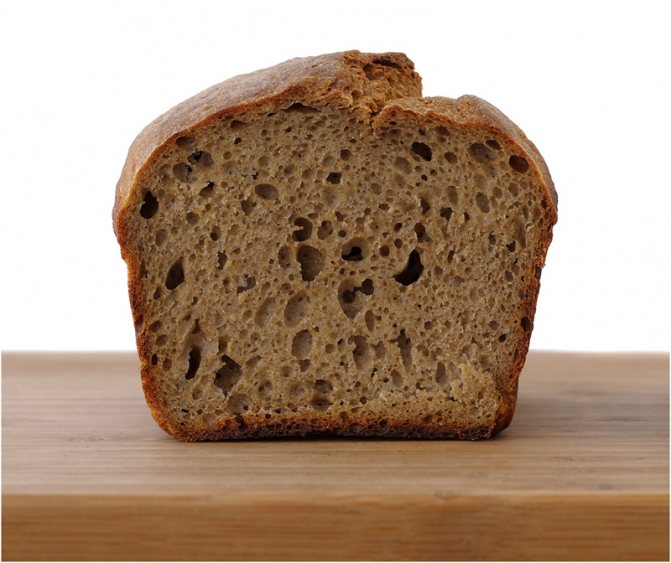
Rye bread is a storehouse of vitamins and beneficial microelements
Foreign and domestic manufacturers have diluted the standard rye bread recipe with their own additives. Additional ingredients include alternative flours, seeds, nuts, plant seeds and colorings.
What are the benefits of rye flour:
As a result, the following varieties of rye bread can be distinguished:
- from peeled flour,
- from wallpaper flour,
- from sifted flour,
- with the addition of wheat flour,
- sourdough rye bread.
You can also find baked rye bread on store shelves. It differs from the simplest rye in that it is made from a higher quality variety of rye flour. This type of bread is considered healthier than regular bread. It includes:
- liquid yeast,
- premium wheat flour,
- sifted rye flour,
- sugar,
- salt,
- water.
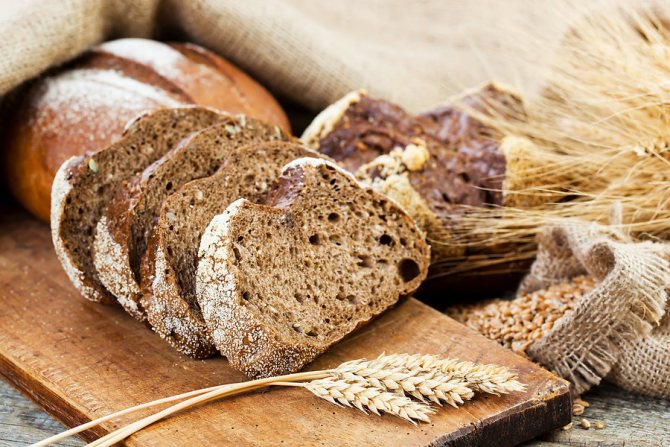
Rye bread made from pecked flour is characterized by high quality
Bread contains many vitamins and beneficial microelements that are so necessary for humans. But despite such a valuable composition and benefits, many choose baked goods made from wheat flour. Perhaps long-established stereotypes that white bread is for the nobility and gray bread for the poor are responsible for this. Nowadays, there are more and more supporters of healthy eating who prefer rye. They combine bread with meat dishes and vegetables, and many people love its sweet and sour taste.
Six to seven slices of bread can provide the human body with half the daily requirement of vitamins and beneficial microelements. A huge difference in composition and beneficial properties can be seen when comparing rye bread with wheat bread.
Table: calorie content and chemical composition of rye and wheat bread (100 g)
| Name | Quantity (for rye bread) | Quantity (for wheat bread) |
| Calorie content per 100 g of product | 259 kcal | 270 kcal |
| Squirrels | 6.6 g | 8.1 g |
| Fats | 1.2 g | 1 g |
| Carbohydrates | 34.2 g | 48.8 g |
| Vitamins | ||
| Vitamin PP | 0.7 mg | 1.6 mg |
| Vitamin E | 2.2 mg | |
| Beta carotene | 0.006 mg | |
| Vitamin A | 1 mcg | |
| Vitamin B1 | 0.18 mg | 0.16 mg |
| Vitamin B2 | 0.08 mg | 0.06 mg |
| Vitamin B5 | 0.6 mg | 0.29 mg |
| Vitamin B6 | 0.17 mg | 0.13 mg |
| Vitamin B9 | 30 mcg | 27 mcg |
| Vitamin E (TE) | 1.4 mg | 1.3 mg |
| Vitamin H | 1.7 mcg | 1.7 mcg |
| Vitamin PP (NOT) | 2 mg | 3.1 mg |
| Kholin | 60 mg | 54 mg |
| Minerals | ||
| Iron | 3.9 mg | 2 mg |
| Zinc | 1.21 mg | 0.735 mg |
| Iodine | 5.6 mcg | 3.2 mcg |
| Copper | 220 mg | 134 mg |
| Manganese | 1.6 mg | 0.825 mg |
| Selenium | 5 mcg | 6 mcg |
| Chromium | 2.7 mcg | 2.2 mcg |
| Fluorine | 35 mcg | 14.5 mcg |
| Molybdenum | 8 mcg | 12.8 mcg |
| Bor | 23 mcg | 48 mcg |
| Vanadium | 40 mcg | 66 mcg |
| Silicon | 7 mcg | 2.2 mg |
| Cobalt | 2 mg | 1.9 mcg |
| Sulfur | 52 mg | 59 mg |
| Chlorine | 980 mg | 837 mg |
| Phosphorus | 158 mg | 87 mg |
| Potassium | 245 mg | 133 mg |
| Sodium | 610 mg | 378 mg |
| Magnesium | 47 mg | 33 mg |
| Calcium | 35 mg | 23 mg |
Video: why rye bread is better than wheat bread
Beneficial features
Based on the composition of rye bread, we can conclude that it is of undoubted value in the daily diet. But not every loaf of bread has a beneficial effect. Often the beneficial substances are removed during the milling and refining of the flour, leaving the bread “empty” and useless. That's why it's so important to choose it wisely. It is best to buy bread made from wallpaper flour (coarsely ground), whole grain or with added bran.
The benefits and harms of sunflower seeds:
The method of preparing the dough is also important. Bread made with sourdough is especially valuable, as it enriches it with lactic acid bacteria, which are so necessary for our intestines.
The main positive qualities of rye bread:
- contains a large amount of vitamins and essential amino acids;
- is a source of fiber (solid indigestible fibers that cleanse the body);
- helps remove toxins and waste;
- helps eliminate constipation;
- prevents dysbacteriosis;
- gives a quick feeling of fullness with the same amount as wheat bread;
- recommended for dietary purposes;
- used for the prevention of cardiovascular diseases;
- recommended for diabetes;
- used for the prevention of cancer;
- accelerates metabolic processes in the body;
- restores hemoglobin levels;
- helps reduce cholesterol levels and remove excess cholesterol;
- recommended for anemia;
- recommended for pregnant women;
- contains one and a half times more iron and 50% more magnesium and potassium than bread made from wheat flour;
- used for the prevention of gastrointestinal diseases.
The greatest benefit from bread can be obtained in the first 36 hours after it is prepared. Then its valuable properties will rapidly decline.
What bread is best to eat for weight loss, for the liver, for the intestines, for pregnant and nursing mothers
To lose weight, wheat bread should be replaced with gray or bran bread . The carbohydrates they contain will give you energy for a long time, reduce the feeling of hunger and cleanse the body.
For liver disease, doctors recommend salt-free products and bread with bran.
For intestinal disorders, products with coarse particles are contraindicated, so whole grain bread should be excluded. For girls at any stage of pregnancy and nursing mothers, it is better to replace wheat bread in their diet with Borodino, rye, black or yeast-free bread.
The benefits and harms of bread for every person are found in every type of product. This is an important element of the diet and you cannot completely abandon its use. After studying the composition and recommendations, you can choose the type of baking that will give the body all the necessary vitamins and minerals and will not adversely affect your health.
Are there any contraindications and is there any possible harm from eating rye bread?
In addition to its benefits, bread with rye flour has contraindications, and if consumed incorrectly, it can begin to negatively affect the human body. It is worth paying attention to the fact that he:
- may worsen the condition of people suffering from high stomach acidity;
- not recommended for stomach ulcers;
- is less easily absorbed and digested compared to wheat bread;
- contraindicated for liver inflammation;
- worsens the condition of people suffering from gallbladder diseases;
- not recommended for use with colic;
- not recommended for duodenal ulcers;
- in large quantities leads to flatulence and digestive disorders;
- if used incorrectly, it leads to weight gain;
- may contain carcinogens, as some manufacturers add flavorings and preservatives to it;
- contraindicated in the postoperative period;
- aggravates the condition of those who have an inflamed esophagus;
- harms people with gluten intolerance;
- not recommended for enterocolitis.
To reduce the adverse effects of rye bread on the human body, manufacturers add wheat flour to the recipe. As a result, rye bread contains 85% rye flour and 25% wheat flour.
What is the best flour for baking bread, in which bread bin is it better to store it?
Industrial white bread is most often baked from a mixture of wheat and rye flour. Homemade bread will not only be tasty, but also healthy from different types of flour. Good flour will have a pleasant smell without mustiness and a sweetish taste. It is sold in natural packaging with a shelf life of no more than six months.
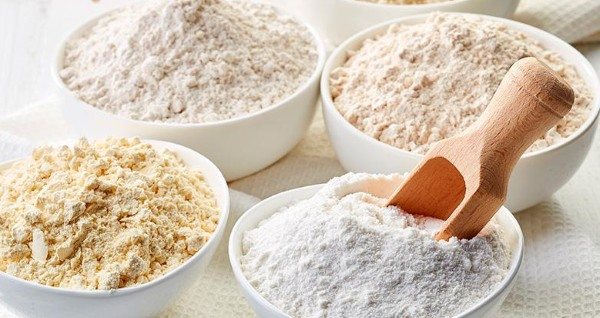
The best types of flour for baking bread:
- Wheat . It is made from part of the grain with a low content of vitamins, which makes it unhealthful and even harmful. Bread made from such flour is intended only to satisfy the feeling of hunger.
- Rye . Tasty and healthy bread can be made from rye and wheat flour in different proportions.
- Buckwheat . Healthy and dietary flour. To prevent the products from falling apart, you need to mix one part of buckwheat flour with two parts of wheat flour.
- Linen . Contains more protein and less carbohydrates than wheat.
Popular until recently, wooden bread bins have replaced stainless steel products. This bread bin does not rust, is not susceptible to mold and rot, is easy to clean and does not absorb odors. The bread stays fresh for a long time. You will have to wash it often, as fingerprints easily remain on the metal surface.
Bread from different varieties should be placed in separate paper bags before storage.
Daily consumption rates
Adult men and women leading an active lifestyle are recommended to consume 250–350 g of rye bread per day to meet their daily requirement of baked goods. Doctors recommend that people who engage in heavy physical labor eat 500 g of bread. If the main activities every day are intellectual work and a sedentary lifestyle, then 150 g of rye bread is enough to maintain the level of necessary substances.
If the daily diet includes wheat and rye bread, then the amount of rye should be at least 25% of the total norm.
Table: daily consumption rates of rye bread depending on age and energy consumption
| Age | Quantity, g |
| Children under 3 years old | no more than 100 |
| 4–6 years | 150 |
| 7–10 years | 220 |
| 11–13 years old | 300 |
| Teenage girls (14–17 years old) | 300 |
| Teenagers (14–17 years old) | 400 |
| People engaged in manual labor (18–59 years old) | 250–500 |
| Elderly people (over 60 years old) | 150–200 |
What is the healthiest bread for a person - white, gray, black?
It is impossible to definitely name the healthiest bread. It all depends on the lifestyle, age and health of the person. What benefits some will be harmful to other groups of people.
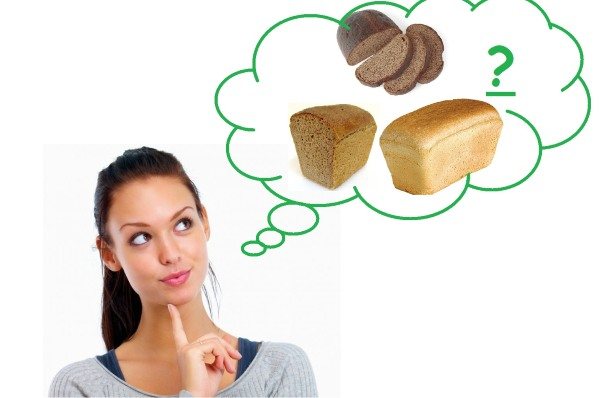
Children, athletes and people leading an active lifestyle need quickly digestible carbohydrates. White bread will cover this need. But it should not be in the diet of overweight people.
The benefits of gray and black bread are significantly higher than white bread . Rye flour in their composition contains all the elements necessary for health. Children under three years old should not be given black bread, as it is quite heavy, and the feeling of fullness comes before the body receives the necessary calories to maintain active development.
Features of use
Rye bread is indispensable for meat dishes, vegetables, it is popular in the form of toast and croutons. It is valued for its taste, mineral and vitamin composition, but it is important to know how to use rye bread correctly.
Is it possible to get heartburn from rye bread?
Quite often, a small piece of fresh, tasty, aromatic bread leads to heartburn. In most cases, the culprits are problems with the digestive system, which also occur in healthy people. The reason for this is intolerance to certain ingredients in rye bread.
A person produces a lot of saliva when a piece of bread enters his mouth. During the chewing process, it begins to break down. At this time, a lot of gastric juice is formed in the stomach, and the lump of bread arrives there already half split. Thus, the complete processing of the piece will require much less stomach acid than was initially released. Its excess irritates the walls of the stomach and can cause ulcers.
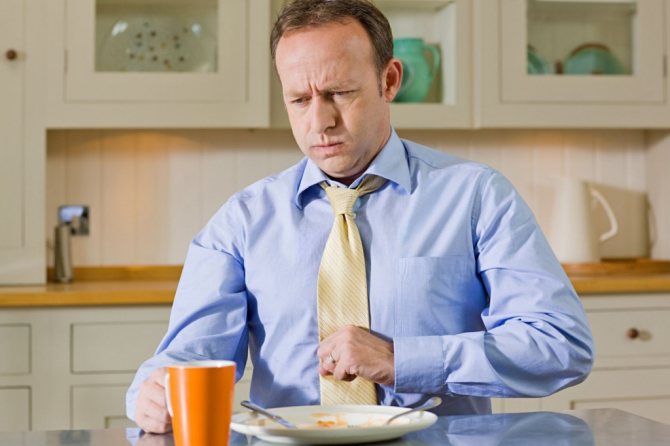
Many components of rye bread can cause heartburn
Not all ingredients in bread are equally healthy. Here are some of its possible ingredients that may cause heartburn:
- Yeast. They help raise the dough and make the bread airy and soft. But when they enter the body with fresh bread, they undergo fermentation and oxidation processes. This is how yeast becomes the culprit of heartburn.
- Pieces of fruit, nuts, seeds, sweets. Seeds and nuts take longer to digest, and sweets (icing, chocolate, etc.) irritate the mucous membrane of the digestive organs.
- Fat (butter or margarine). This mainly applies to homemade baking. Housewives do not skimp on good butter or high-fat margarine. This makes the bread tastier and more aromatic, but it will be harder for the stomach to digest. Because of this, the product stagnates in the body longer and can cause heartburn.
To avoid heartburn, doctors and nutritionists recommend:
- buy not fresh, but yesterday’s bread;
- observe the daily bread allowance;
- eat together with other foods;
- choose black bread with the simplest composition, without additives;
- give preference to unleavened bread;
- cook it at home with low fat ingredients.
Is it possible to have rye bread during pregnancy?
During pregnancy, women often crave rye bread. The reason for this is yeast, which contains a lot of vitamin E. Doctors recommend including this bread in your diet, but without yeast in its composition. It provides energy and causes minimal harm to the child. They are also advised to choose bread with minimal acidity so as not to cause pain in the intestinal area.

To make sure whether you can eat rye bread during pregnancy, you need to consult your doctor.
During pregnancy, it is better to replace bread with other equally healthy products, but you should not give it up completely. You should choose the simplest bread and adhere to the norm for its consumption.
The norm of rye bread for a pregnant woman is 100–150 g per day. Doctors do not recommend exceeding the norm, so as not to harm the child.
In the diet of a nursing mother
As during pregnancy, during breastfeeding, rye bread was and remains much healthier than white bread. It gives energy not only to the mother, but also to the baby. It improves muscle tone, maintains the beauty and elasticity of the skin, and prevents the development of cellulite. But exceeding the consumption limit can harm not only the mother, but also the child. It should be introduced into the diet of a nursing mother little by little and gradually watch the baby’s reaction (behavior, stool, rashes). Pediatricians and nutritionists do not recommend combining it with fatty foods. It is tasty and healthy to eat in dried form.

During breastfeeding, bread improves the health of the mother and gives energy to the baby
Mothers feeding their babies with breast milk should give preference to rye bread with the simplest ingredients, without fillers or additives. Flavorings and additives in the form of fruits, nuts, seeds and sweets can be the main cause of allergies in a baby. They can also worsen the functioning of the mother’s gastrointestinal tract, and this will lead to a decrease in the value of breast milk. When choosing rye bread, adhere to the following rules:
- Do not buy fresh bread, as it leads to constipation for mother and child. You should give preference to day-old bread, as it stimulates digestion.
- Choose a well-baked product. This is checked this way: squeeze the bread, if it is well baked, it will return to its shape, otherwise it will remain deformed.
- The smell of bread should not contain baked goods. This means that it contains dough improvers, which cause an allergic reaction in infants.
- Pay attention to the structure. If the bread is too porous, this is evidence of yeast activators in the composition. They are of no use.
- Buy bread in plastic bags with recent baking dates. Products that have been baked for a long time may contain mold.
Rye bread in a child's diet
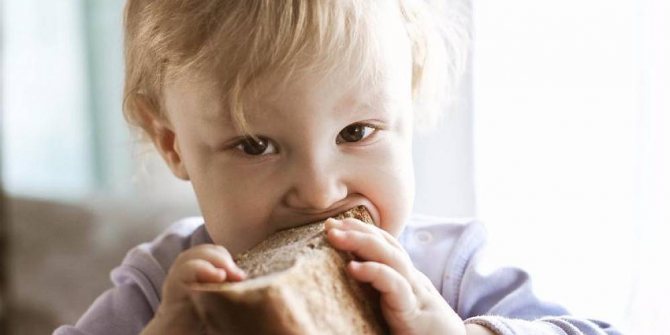
The best time to introduce rye bread into a child’s diet is 3 years.
Pediatricians advise giving bread to babies from 7 months of age in the form of crackers. But rye bread should be introduced into the diet only after 3 years. This is explained by the fact that the enzymes in the child’s digestive system are not yet sufficiently formed and cannot break down the complex components of bread. From the age of 3, bread is given in an amount of 10–15 g. The child’s reaction is observed for a couple of days and if the reaction is normal, the volume is increased to 100 g per day.
Black bread is indeed healthier for an adult. Rye flour contains more B vitamins and iron than wheat flour. Between us, white bread made from premium flour is an unhealthful product. They eat it simply because they eat it. You shouldn't expect much benefit from it. Rye bread contains more fiber. So it is preferable for an adult.
Why it should not be given to small children, especially at 10 months. This is due to the technology of making rye bread. It is made only with sourdough. Plus, rye flour itself has a higher acidity than wheat flour. That is, rye bread is definitely more “sour” than wheat bread. And wetter. Therefore, it is more difficult to digest and is not even recommended for people with high stomach acidity. So I wouldn’t give a child one year old, or even two years old, rye bread. By the way, I don’t give you wheat, and we get by calmly.))
It's up to you, good luck!
Natalia, food technologist
https://www.babyblog.ru/community/post/baby_food/1218614
For what diseases can you include bread in your diet?
Despite its rich composition and beneficial properties, rye bread is not healthy for everyone. This is especially true for people suffering from various ailments. To use it calmly and not be afraid of negative effects, you need to consult a doctor.
For diabetes
Rye bread, in comparison with white bread, does not increase blood sugar levels. Bread with bran is especially valuable. It has 10-15% fewer calories and contains more dietary fiber, which is good for preventing this disease. It contains a lot of vitamin B and slow carbohydrates, which contribute to the normal functioning of the hematopoietic organs.
Preference should be given to black bread with a glycemic index of 51. It contains 15 g of carbohydrates and only 1 g of fat. The best option is Borodino bread. The permissible amount of bread per day depends on the amount of carbohydrates consumed in other foods. If your diet contains a lot of carbohydrate-containing products, then the norm for rye bread is 25 g, otherwise - no more than 325 g of bread per day.
For thrush
During an exacerbation of the disease, the patient should refuse any baking. Since rye bread most often contains yeast, it can aggravate the disease. At other times, you don’t need to give it up, you just need to buy yeast-free, day-old and whole grain bread. Its norm in the daily diet is 200 g.
For cholecystitis
Doctors recommend eating black stale bread in the daily menu during the recovery period. It promotes healthy bowel function and gallbladder emptying. Its norm is 2-3 dried pieces per day. But during periods of exacerbation of the disease, rye bread is strictly contraindicated. Only white stale bread is allowed. It is lighter and does not burden the digestive system.
For gastritis
During an exacerbation, doctors do not recommend consuming rye bread. This can lead to nausea, heartburn and even loss of consciousness. The reason for this is the ingredients of bread. If it's fresh, it's harder to digest. Yeast leads to fermentation in the intestines, bloating and flatulence. Increased acidity can aggravate gastritis and cause ulcers. All this only complicates the functioning of the gastrointestinal tract and can cause harm. But for gastritis, crackers made from rye bread are allowed. The exception is Borodino bread, as it has quite high acidity. The norm for such crackers per day is 100 g.
For pancreatitis
As with other diseases, rye bread is contraindicated during an exacerbation. It can lead to destruction of pancreatic tissue, diarrhea, intestinal pain and gas formation. But during the recovery period, rye crackers are allowed. They can be soaked in tea or broth. The daily norm is 100 g.
Losing weight on black bread
Many diets use black bread. It is healthier than regular white, you feel full faster, and it contains many valuable microelements. If you consume it without exceeding the norm, it will not lead to weight gain.
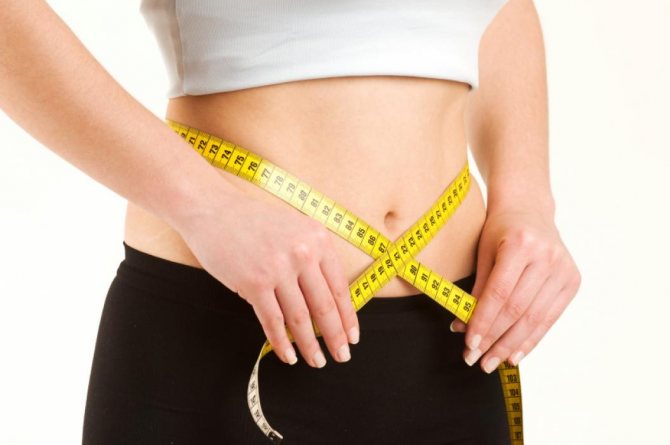
Rye bread is often used in diets
For example, in a mono-diet of black bread and water, you can get rid of a couple of extra pounds in 3-5 days. There are several options for this diet. The simplest is to eat only bread and water for several days. But such a diet caused only negative reviews.
There is a more gentle and effective option. You need to eat 3 times a day. Breakfast consists of 1 small bowl of oatmeal with water, 1 slice of rye bread and a cup of green tea without sugar. Lunch - 2 slices of bread and tea without sugar. Dinner - 2 glasses of milk and 2 slices of bread. During the day you need to drink 2 liters of water. And in the morning on an empty stomach you need to drink 1 glass of water. After this, you cannot eat for half an hour. The duration of the diet is no more than 5 days. It is not recommended to carry it out more than once every six months.
A popular diet is 7 days on rye bread, following which you can lose 6–7 kg. The menu for this diet is more varied.
Table: diet menu for 7 days
| Breakfast | Dinner | Dinner | |
| Monday | 50 g oatmeal, steamed in water or milk, 1 slice of rye bread, tea without sugar | 3 slices of rye bread, black tea without sugar | 2 slices of bread, 2 glasses of milk |
| Tuesday | 2 slices of bread, tea with milk 50/50 without sugar | 50 g oatmeal, steamed in water or milk, a glass of milk | 2 slices of bread, 2 mugs of tea without sugar |
| Wednesday | 2 glasses of water, after 20 minutes 2 slices of bread | 50 g oatmeal, steamed in water or milk | 1 slice of bread, 1 glass of milk |
| Thursday | 2 glasses of water, after 20 minutes 3 slices of bread | 2 glasses of milk, 2 slices of bread | 50 g oatmeal, steamed in water or milk, black tea without sugar |
| Friday | 50 g oatmeal, steamed in water or milk, 1 slice of bread, black tea without sugar | 50 g oatmeal, steamed in water or milk, 1 glass of water | tea without sugar, 2 slices of bread |
| Saturday | 50 g oatmeal, steamed in water or milk, 2 slices of bread, black tea without sugar | a couple of slices of bread, tea without sugar | tea without sugar, 1 slice of bread |
| Sunday | 2 slices of bread, black tea without sugar | 50 g oatmeal, steamed in water or milk, 1 slice of bread, 1 glass of water | 3 slices of bread, 1 glass of milk |
During the diet, you need to perform physical exercises that will help you effectively lose weight and tone your body.
Reviews from those who have lost weight
Hello everyone...I read about the bread diet...of course it’s interesting...Well, I lost weight differently.
In the morning I ate porridge or omelet, 1 piece of bread and butter. At lunch, a full diet of 1 and 2 and, of course, tea or compote. An afternoon snack of two mugs of kefir. In the evening, also porridge or mashed potatoes. I did not eat after 7 pm. And my food was not an ounce of salt! And I didn't drink coffee. there was meat only at lunch. I weighed 120 kg and now I’m 80. This is in 1.5 months. Now the skin is hanging on my hands... Natalch
https://edimka.ru/cgi-bin/cm.pl?r=diets_hleb
Good evening everyone, today my monthly bread diet ended, I lost 11 kg, I didn’t expect that I would just lose 5-7 kg, to be honest, I had difficulties in terms of constipation, I drank Duphalac every other day, maybe this also affected the weight loss. height 160 weight was 65 now 54.
Nyusha
https://edimka.ru/cgi-bin/cm.pl?r=diets_hleb
Rye bread for a hypoallergenic diet
Children's bodies are very weak after birth, and any product can cause allergies. And since all substances reach the baby through mother’s milk, any product eaten by the mother can become a strong allergen for the baby. In order not to harm the baby, maternity hospitals recommend that mothers follow a hypoallergenic diet.
The main task of such a diet is to avoid the appearance of rashes, itching, redness, the appearance of crusts, loose stools or, in especially severe cases, swelling of the respiratory tract due to foods and their components. Allergies may also appear later in a child.
Recent Entries
Is it possible to give a mirror: how to protect yourself from bad omens It became known about the influence of cell phone towers on human health Is it possible to eat bananas bought in Russia?
The diet divides foods into groups. Rye bread is included in the group of hypoallergenic products. It is definitely included in the menu of a nursing mother. Pediatricians classify it as a food that does not cause allergies. The amount of bread per day should be 20–30% less than the standard amount of baked goods for a healthy person. When on a diet, only 2-3 pieces per day are allowed.
Bread after 40 years
After 40 years, you need to take the foods in your daily diet most seriously in order to keep your body healthy longer and live a long life. At this age, food should be less caloric, since the body spends less energy than in youth. Priority should be given to foods with a low glycemic index. During this period, it is important to monitor bowel movements and daily bowel movements. The best assistant in this is rye bread and other fiber-rich foods. Its regular use helps to maintain normal functioning of the entire gastrointestinal tract.
Video: proper nutrition after 40 years
Bran bread
Enlarge picture
This type of bread contains small particles of the outer grain shell, which do not go into the dough when baking a regular black or white loaf. However, bran is a real storehouse of vitamins and minerals, which makes it possible to include a product containing them in the category of dietary products.
Benefit:
- due to the high content of coarse fiber, bran bread acts as a “broom” that cleanses the intestines of toxins;
- promotes the active functioning of the stomach and metabolism (wheat bran);
- reduces the risk of atherosclerosis by lowering cholesterol levels (oat bran);
- tidies up the condition of the skin and hair;
- excellent prevention of fungal infections;
- the product is rich in vitamins, selenium and zinc, which has a beneficial effect on the reproductive system of women;
- starchy complex carbohydrates provide additional energy for the brain;
- helps fight fatigue, improves the functioning of the heart and blood vessels (rye bran).
Harm:
- with excessive consumption, intestinal function is disrupted (flatulence, diarrhea);
- deterioration of colitis and gastritis;
- sometimes, to improve the appearance (and the addition of bran makes the loaf flat and inelastic), dough improvers containing bromates that are harmful to health are added to the composition;
- Cellulose and pectin contained in bran slow down the absorption of calcium in the body.
Health Recipes
Nowadays, there are a huge number of different variations of bread baking. But the simplest ones (with a minimum number of ingredients) are considered the best and healthiest.
Homemade rye bread from a bread machine
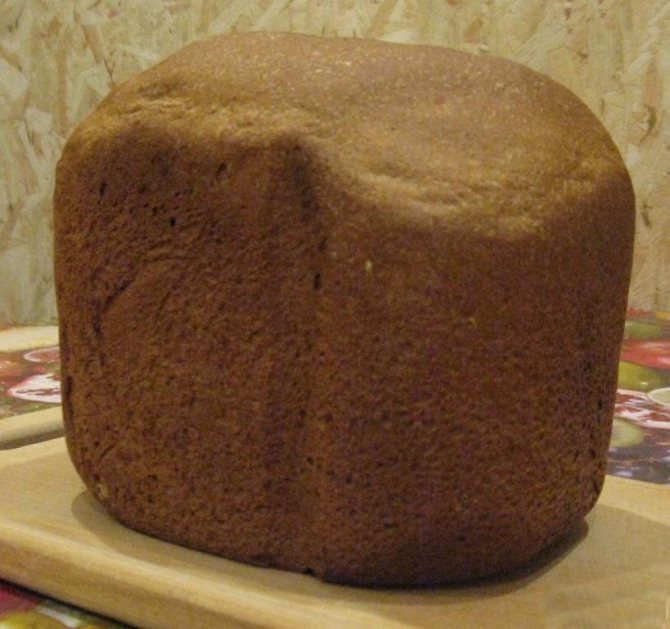
The most natural and healthy bread is homemade
Ingredients:
- rye flour - 350 g;
- high activity yeast - 1 dessert spoon;
- olive oil - 1 tablespoon;
- whey - 250 ml;
- dried cumin - 1 dessert spoon;
- salt, sugar to taste.
Recipe:
- Pour all the ingredients for the recipe into the bowl of the bread machine. Do not stir.
- Select the “Rye bread” mode and bake for 3 hours.
By cooking at home, you can adjust the acidity of the bread. To increase acidity, whey or ripe dough is added to the dough.
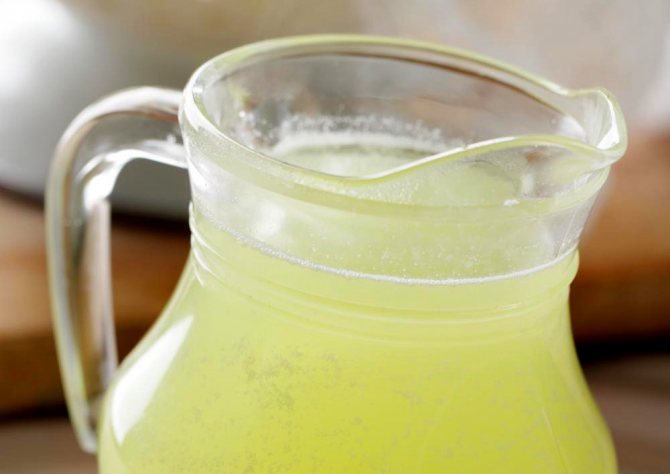
Whey serves to increase the acidity of the product
Treatment of joints and gout with rye bread gruel with kefir
Ingredients:
- Rye bread,
- kefir,
- baking soda.
Recipe:
- The bread is crushed into pieces.
- 1 glass of kefir is poured into a jar with a capacity of 500 ml and bread is added.
- 1 dessert spoon of baking soda is also added there.
- The gruel is left for 5–6 hours, then filtered and squeezed.
You need to make compresses from the resulting pulp at night. Apply to problem areas. Duration: 3–4 nights.
Yeast-free bread
This bread does not cause colic or fermentation in the intestines. It is great for almost everyone and is recommended for many diseases.
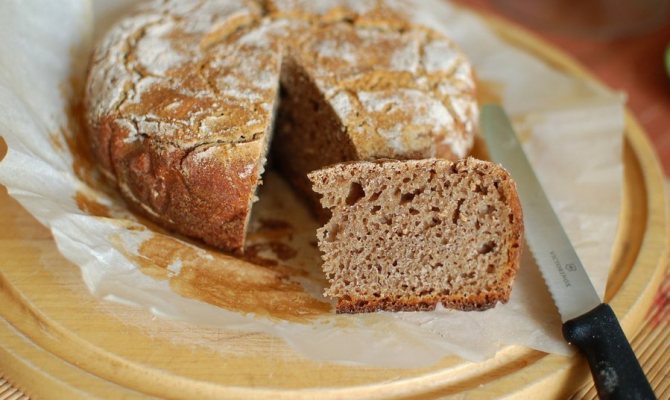
This bread does not cause bloating or heartburn.
Sourdough ingredients:
- rye flour - 100 g;
- warm water - 80 ml.
Ingredients for the dough:
- sourdough with rye flour or dough - 200 g;
- rye flour - 500 g;
- hard-brewed black tea - 140 ml;
- sugar - 1 dessert spoon;
- salt - 1 dessert spoon;
- butter to grease the baking dish.
Recipe:
- First, the dough is made. To do this, the starter is mixed with flour and water.
- The resulting dough is wrapped in film and left for 3.5–4 hours. In this case, the temperature should be 25–28 degrees.
- After time, the dough should rise. Flour, hard-boiled tea, salt and sugar are added to it.
- The dough is kneaded. It will turn out dense and sticky. You no longer need to add flour to the dough.
- The dough is again wrapped in film for 60–90 minutes at a temperature of 30 degrees.
- After the time has passed, the dough is moved with wet hands onto the table and shaped.
- After which it is transferred to a greased form and left for 35–40 minutes.
- In an oven preheated to 250 degrees, bake the bread for 10 minutes.
- After which the bread is baked for 25–30 minutes at a reduced temperature to 190–200 degrees.
Bread with honey for calluses, bones and spurs
Ingredients:
- Rye bread,
- linden honey
Recipe:
- Take a crumb of rye bread and mix it with linden honey in a 2:1 ratio.
- Before treatment, your feet need to be steamed.
- The resulting mixture is applied to the affected area and the whole thing is secured with a bandage or plaster.
- Wear for 2-3 days. Then the bandage must be removed.
If necessary, you can repeat. In 3–5 courses it is possible to get rid of even old hardened calluses.
To increase the effectiveness of treating bones and spurs, you can take baths with plantain or chamomile daily. To do this, make an infusion of herbs in the proportion of 1 liter of boiling water to 1 tablespoon of herbs. Clean feet must be steamed in this solution.
GOST 28807 90 on the composition of bread made from a mixture of rye and wheat flour
When choosing bread, it is recommended to focus on those products that are made according to the GOST standard No. 28807 90, that is, the composition and manufacturing criteria of the product meet all the standards established by a special commission.
The composition of rye-wheat bread, according to GOST No. 28807 90, includes the following components:
- peeled rye flour for baking;
- wheat flour for baking;
- compressed baker's yeast;
- table salt;
- possible presence of fermented milk products and sugar;
- natural additives: cumin, various types of herbs and seeds, spices.
According to established standards, bread must be produced in a mass of no less than half a kilogram.
At the same time, its shape must be appropriate to the type of bread, without additional contaminants falling on its surface.
As for the color, it should be from light brown to dark brown, without any burnt marks on the surface of the product.
The structure of the baked product should be particularly uniform without pronounced irregularities and dents.
Getting wet and crushed into small lumps is not allowed according to the established standard.
The inside should be without any unmixed parts and completely baked. GOST establishes the issue of taste and smell as follows: the smell and taste must be characteristic of this product without additional flavorings.
Beauty Recipes
When choosing ingredients for recipes, you should consider your skin type and hair condition.
For hair
Rye bread in hair beauty products enriches it with vitamin B, promotes hair strengthening, rapid growth, fights dandruff, improves blood circulation and helps restore the structure of the hair itself. Due to its acidity and high protein content, it makes hair more manageable and shiny. They are easier to comb and do not get tangled after washing. Systematic use of rye bread in hair recipes helps to avoid premature gray hair and preserve color and youth longer.
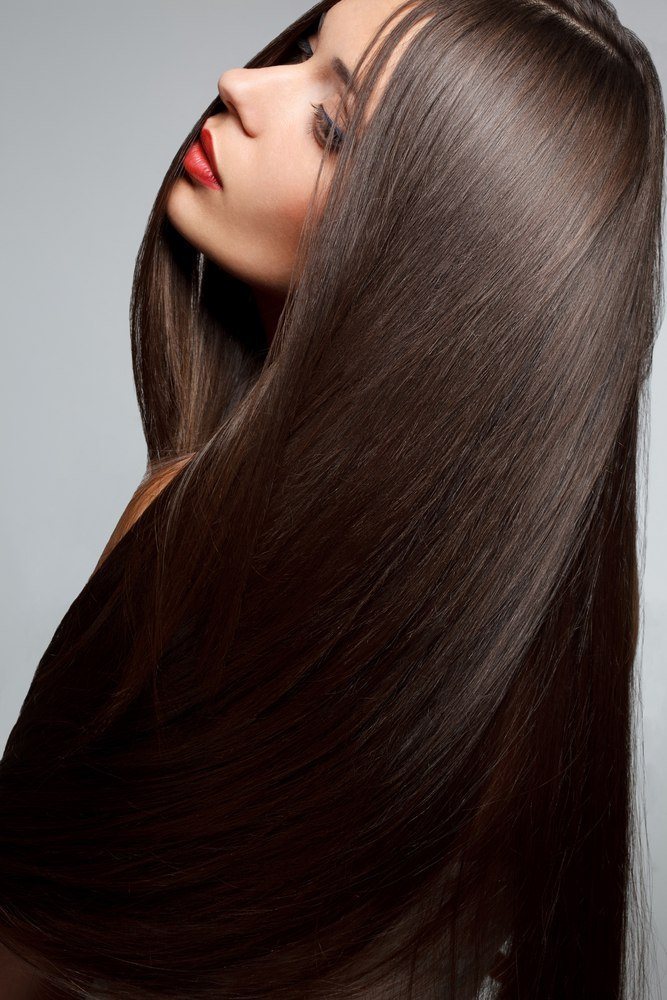
Rye bread improves hair condition, the effect is noticeable from the first use
Mask to activate hair growth
Rye bread needs to be poured with boiling water and left to steep for 2-3 hours. Afterwards, the bread is squeezed out, and the remaining liquid is applied to the hair roots and left for half an hour. It is better to apply to unwashed hair. After the time has passed, wash the mask off your hair with shampoo and rinse with water and a few drops of lavender essential oil. The number of repetitions for the best effect is 3 times for 5 procedures with a break of 1 month.
Rye bread shampoo
Borodino bread is best suited. We chop it into pieces and dry it. These pieces are brought to the state of crumbs in a blender. Before washing your hair, the crumbs are diluted in a small amount of water. Afterwards it is rubbed into the skin with massage movements and rinsed off generously so that there are no crumbs left in the hair.
Anti-dandruff remedy
Stale rye bread 100–150 g is poured with boiling water and kept until it becomes a paste. It is applied to the hair. Then you need to wait 30–40 minutes. The mixture is washed off with clean water. Instead of shampoo, you can use an egg or yogurt. The recommended number of procedures is 10 times.
To remove dye from hair
Kefir is mixed in equal parts with rye bread crumb and applied to the hair. You need to keep it for 1.5 hours. Afterwards it is washed off with water.
Benefits of oatmeal for skin, face, hair and digestion:
For skin
In recipes for skin beauty, cosmetologists recommend using bread crust instead of crumb, since during the cooking process it produces many antioxidants that have anti-cancer properties.

Bread face masks have been very popular for many years now among those who really care about their appearance.
Mask for oily skin
The peel of a green unsweetened apple is poured with boiling water in a volume of 150 ml. Add the rye bread crumb to the resulting mixture. Stir until you get a consistency like sour cream. Wash, cleanse and steam your face. Apply the mask along the massage lines. Keep for 15 minutes. After time, wash your face with infusion from the series. To prepare the infusion, pour 1 tablespoon of the herb into a glass of boiling water. The number of procedures is 2–3 per week. The duration of the course is 21 days.
Pore tightening mask
Soak the bread in milk until mushy. You must first cleanse your face and dry it. Apply the mask along the massage lines and hold for 20 minutes. Then rinse off with cool water. You can make a mask no more than 3 times a week.
Whole wheat bread
Enlarge picture
It began to spread widely recently, in the wake of interest in proper nutrition. Bread is made from whole grains (sprouted according to some technologies) or many grain mixtures; the finished product contains the outer shells of the grain, which contain a lot of useful substances. For example, the most popular representatives of the assortment are “Barvikhinsky” bread made from crushed wheat semolina, as well as “bricks” from sprouted grain “Tonus” (whole grain yeast-free bread).
Benefit:
- during germination and subsequent storage of grain, the content of vitamins in it increases several times: vitamin B1 - 1.5 times, B2 - 13 times, other B vitamins - 5 times, vitamin C - 5 times, folic acid – 4 times;
- to obtain the dough, the grain is not ground, but is immediately turned into dough on special units, all vitamins and microelements are completely preserved, no chemical additives are used;
- fermentation of the dough using lactic acid bacteria ensures the preservation of almost all substances contained in the whole grain (germ, dietary fiber, vitamins, minerals, protein, etc.);
- the presence of dietary fiber makes whole grain bread an effective sorbent;
- A loaf of sprouted grains surpasses all traditional types of bread in its nutritional and biological value.
Sourdough bread without yeast
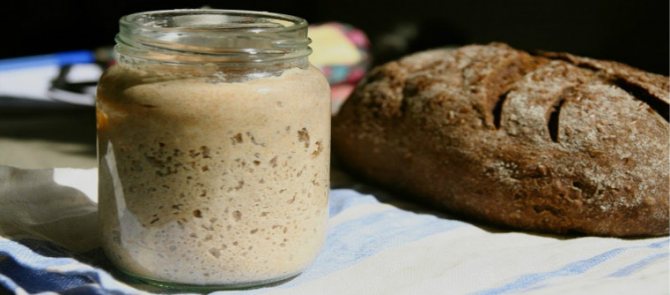
Recently, more and more people are trying to buy or prepare bread without yeast. It can be either black or white, it doesn’t matter. But such baked goods are digested much better, facilitate digestion and do not cause flatulence, bloating and dysbacteriosis.
To make yeast-free bread, you need sourdough, which can be prepared at home. However, the process requires time and patience.
- Take 50 g of rye or wheat flour and drinking warm water. Stir the flour in a liter jar and put it in a dark and warm place for a day.
- After a day, the starter should ferment and increase in volume. Again, add 50 g of flour and warm water to it and leave it warm for a day.
- On the third and fourth days, we do the same: add 50 g of flour and water, mix and leave warm.
- After 5 days the starter is ready. It will increase in volume to 400 ml, will foam and bubble. From this amount you need to separate 100 g of starter and put it in the refrigerator for next time. The remaining amount can be used to make homemade bread.
- The so-called starter starter, that is, the very 100 grams that you selected, should be stored in the refrigerator. It requires regular feeding, that is, periodic addition of flour and warm water, as indicated at the beginning of the process.
Calorie content of crackers and fried bread
Rusks are very often used as an addition to hot liquid dishes and salads. Recommendations for their inclusion in a healthy diet are associated with the content of a large amount of nutrients and vitamins (magnesium, phosphorus, iron, potassium, sodium, etc.), as well as a low level of gluten, which helps normalize the functions of the digestive tract.
Per 100 g of product of different varieties there are:
- 331 kcal – loaf;
- 210 kcal – black bread;
- 395 kcal – breadcrumbs;
- 180 kcal – rye bread;
- 410 kcal – crackers with raisins;
- 230 kcal – gray bread.
Croutons, like biscuits with bread, are a good base for snacks and sandwiches. Fried crispy bread supplies the body with a lot of carbohydrates, zinc, phosphorus, copper, potassium, calcium, vitamins PP and B, as well as saturated and polyunsaturated acids. The calorie content of croutons directly depends on the type of bread and the additive on which it is fried. When using 3 g of butter (23 kcal) and a piece of black bread (73 kcal), the snack will add 96 kcal. On average, 100 g of croutons can contain up to 407 kcal.
Use in folk medicine
In Rus', rye pastries were consumed not only as a staple food, but also as medicine.
Our ancestors used black loaf to treat stomach upsets, coughs, sore throats, skin problems, headaches and even insomnia. For diarrhea, for example, they drank a water infusion made from bread. To do this, 1-2 slices of the product were poured with half a liter of cold water and left for several hours in the cold. Then the strained liquid was consumed in half a glass every hour.
To get rid of headaches, traditional healers advised applying pieces of black loaf soaked in plantain juice to the temples for 15 minutes.
Ordinary rye bread, sprinkled with salt and chopped garlic, was used as an anthelmintic. The same drug was considered one of the most effective for treating colds or flu. A severe cough was once treated with “mustard plasters” made from slices of rye pastry. To do this, sprinkle a tablespoon of mustard on a thick piece of stale product and pour boiling water over it. Then a slice of bread was taken out of the water, wrapped in gauze and applied to the chest or back like a mustard plaster. Something similar was used to treat sore throat. The bread was also poured with boiling water, but without mustard. The soaked pulp was tied to the neck overnight. And to treat a runny nose, it was advised to inhale the smoke of burnt rye bread.
In Rus', black bread was also used to get rid of boils. A piece of the product was thoroughly chewed and then applied to the boil. By the way, black loaf is also useful for treating acne. If you pour hot water over the pulp, then squeeze it out and mix it with honey, you get a medicinal paste against acne.
It is useful to apply this mixture to problem areas twice a week and keep it as a mask for 15-20 minutes.
Selection rules
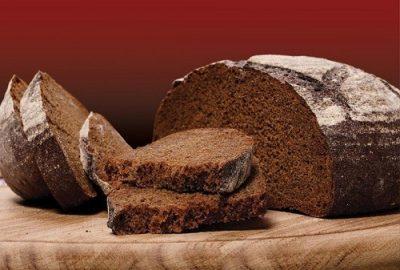
A pure rye product is not suitable for everyone, so most people opt for the rye-wheat variety. An important role in choosing a product is played by taste, namely, various types of additives. Having chosen the most suitable type of product, it is advisable to inspect the appearance of the baked goods for defects or color changes, which indicate the degree of baking of the product.
How long does rye bread remain usable? The package label contains this important information. It shows the date of manufacture, shelf life, composition, calorie content and nutritional value. The residence time of bread in stores ranges from 24 to 36 hours from the moment of baking.
